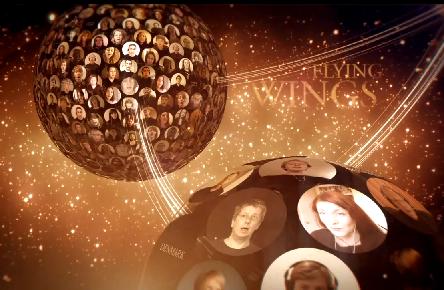Crowd Sourced Choir Sings Over Internet With the Power of 2000 Voices (video)

Share
The internet has quickly become the place where everyone's voice can be heard...literally. The Virtual Choir project collected 2052 self-made recordings of people performing the same song and then recombined these efforts into one collaborative work of art freely available on YouTube. Check out the entire performance of Sleep in the video below. It's absolutely stunning to watch and hear.
The Virtual Choir was the brainchild of Eric Whitacre, a modern composer who pushes the boundaries of musical performance. Sleep is now included as the final track in his latest album, Light & Gold, available on Amazon. Originally looking to collect 900 voices starting in September of 2010, Whitacre eventually gathered more than two thousand recordings from 1752 singers living in 58 different countries. Not only is this performance crowd-sourced, it represents collaboration on a global scale. This is just the lowest level of massively multi-user online projects that we can expect to see in the years ahead. Prepare yourself for virtual artworks that involve millions of people from around the globe as billions more of us go online in the next few decades. The future will be filled with mega-art.
Don't be intimidated by the 9 minute run time of the Sleep video, the last four minutes are just the credits. It takes some time to thank 1752 people individually!
Before its YouTube debut on April 7th, Whitacre discussed the creation of Sleep at TED 2011. In the following video you get to see some of the behind-the-scenes auditions, as well as hear about Whitacre's motivations and thoughts on this colossal project. Interesting stuff:
Be Part of the Future
Sign up to receive top stories about groundbreaking technologies and visionary thinkers from SingularityHub.


While editing and mixing 2000+ voices was a herculean effort on Whitacre's part, I'm hesistant to call this project unique. We've seen some really beautiful crowd-sourced music videos before, and the genre is almost as old as YouTube itself. Other crowd-sourced driven art projects, like Kevin MacDonald's The Life in a Day, may not focus on music, but they are creating thematically similar products: a sublime performance cobbled together from many other lesser efforts. Sleep is a weighty example of this new approach to art, but it's not the largest, and even if it was, it would be outpaced by some other project fairly soon. That form of escalation seems inevitable, especially as we develop video editing software that is fueled by narrow artificial intelligence. At some point, almost anyone should be able to gather thousands of videos, feed them into a program, and produce a crowd-sourced piece of their own.
Yet the size of the crowd is just one factor that seems destined to increase. The other is complexity. Or perhaps, ability. We've discussed Chris Anderson's belief that crowd-sourcing can accelerate innovation when individuals with a common interest are allowed to collaborate freely and quickly. It seems likely that as we create more and more of these massively multi-user online projects the rate at which they develop will increase as well. Not just bigger crowds, but crowds that interact and intermix more rapidly as more people become involved. This kind of art could accelerate, so to speak.
For now, Whitacre's Sleep is simply a wonderful reminder of the beauty humans can create when they combine their voices together in harmony. Enjoy the song, but don't be lulled into thinking this is the best we can accomplish. The greatest successes with this trend of crowd-sourced art are yet to come.
[screen capture credit: Eric Whitacre/The Virtual Choir]
[video credits: Eric Whitacre, TED]
[sources: The Virtual Choir]
Related Articles

This Week’s Awesome Tech Stories From Around the Web (Through December 20)

Data Centers in Space: Will 2027 Really Be the Year AI Goes to Orbit?

New Gene Drive Stops the Spread of Malaria—Without Killing Any Mosquitoes
What we’re reading
